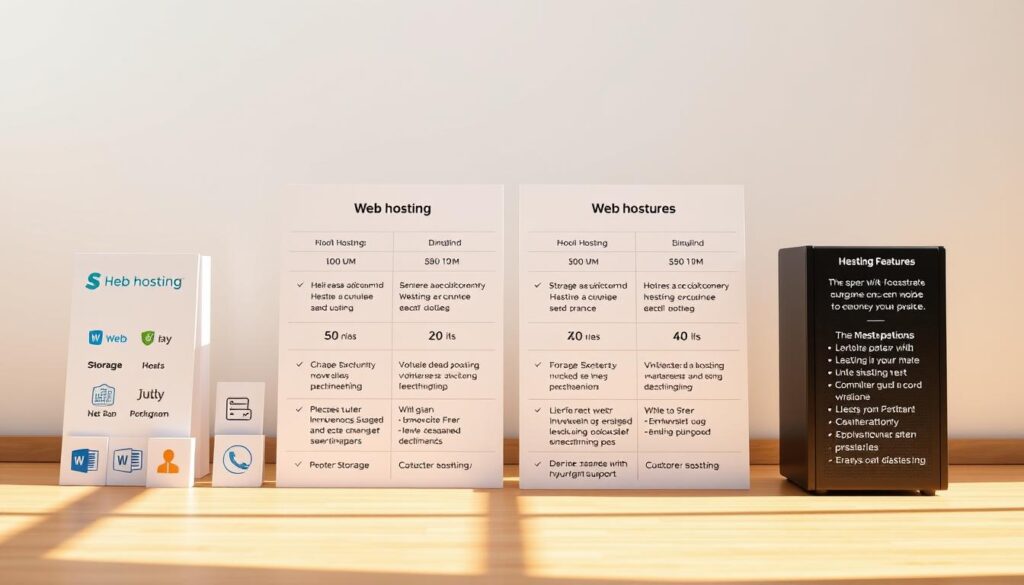Launching an online presence is an exciting step. The selection of a web platform is a foundational decision that affects everything from speed to security. A strong start sets the stage for long-term growth and a positive visitor experience.
Many new creators worry about technical complexity and cost. They fear making a poor choice that could hinder their project. Modern solutions, however, have evolved to be incredibly user-friendly.
Providers now offer intuitive control panels and helpful support teams. These resources eliminate the need for deep technical knowledge. This guide will cut through the jargon to deliver clear, practical advice.
Readers will explore different hosting plans, essential features, and performance metrics. The goal is to provide the knowledge needed to select a service that aligns with specific goals and budget. Making this critical choice does not have to be overwhelming.
Understanding the Importance of Web Hosting for Your Site
Creating an effective internet presence requires thoughtful consideration of where your digital assets will reside. This foundation determines how visitors experience your content and how search engines evaluate your pages.
What is web hosting?
Web hosting provides secure online space to store all site files. This includes code, images, text, and other content. The service makes a web presence accessible to visitors worldwide.
Think of hosting services as the physical land where a building stands. Similarly, a digital project needs server space to exist online. Providers maintain powerful computers in specialized facilities.
Why hosting matters for your online presence
Hosting quality directly affects site speed and user experience. Faster servers deliver content more quickly to visitors. This improves engagement and search engine rankings.
Poor hosting leads to slow loading times and frequent downtime. Security vulnerabilities can damage business reputation. Potential customers may leave before pages even load.
Reliable hosting provides stability for consistent visitor access. It ensures your site handles traffic spikes during promotions. When people search for information, your content remains available to serve them.
The right hosting solution influences every aspect of online success. From page load speeds to handling viral moments, proper infrastructure supports growth and maintains professional standards.
Defining Your Needs as a First-Time Website Owner
A thoughtful assessment of individual needs forms the foundation for choosing appropriate web infrastructure. This process helps align technical resources with specific project goals.
Identifying key features
New creators should begin by determining their site’s purpose. Different projects—blogs, portfolios, business pages, or online stores—have unique technical demands.
Realistic traffic estimates are crucial. Most new platforms start with modest visitor numbers that grow gradually over time. This affects server capacity requirements.
Essential features deserve early consideration. Professional email accounts, SSL security certificates, and content management systems represent critical components for many projects.
Storage needs vary significantly based on media types. Text-based content requires minimal space, while photography or video demands substantial capacity.
Future expansion potential should influence initial decisions. Scalable solutions prevent disruptive migrations as audience numbers increase.
Budget considerations remain important, but the cheapest option rarely delivers the best long-term value. Technical comfort level also determines whether managed services or self-administered solutions work better.
Creating a feature checklist helps distinguish must-have elements from optional extras. This focused approach streamlines the selection process.
Hosting for First Website: Essential Considerations
Making an informed choice requires a systematic comparison of available options. Several critical factors distinguish superior services from mediocre ones.
Key Criteria to Compare Providers
Evaluating different companies involves looking at several core areas. A careful review prevents future headaches.
- Uptime guarantees are vital. Look for a commitment of 99.9% or higher. This ensures your site stays online for visitors.
- Scrutinize the pricing structure. Introductory rates are often low, but renewal costs can jump. Understand the long-term price of plans.
- Check resource allocations like storage and bandwidth. Your chosen package must meet your site’s demands.
- Compare included features. Free domains, SSL certificates, and email accounts add significant value.
- Research the provider’s reputation. Read customer testimonials and independent reviews to gauge real-world experience.
- Ensure clear scalability options. Your needs will grow, and upgrading should be simple.
- A money-back guarantee offers a safety net. A 30-day period allows you to test the service properly.
- Finally, assess support quality. Fast, knowledgeable help is crucial when issues arise.
This checklist provides a solid foundation for selecting a reliable partner. It turns a complex decision into a manageable process.
Breaking Down Different Hosting Plans and Options

Navigating the landscape of online infrastructure begins with understanding the core types of services available. Each option offers a distinct balance of cost, control, and capacity.
Shared vs. VPS vs. Cloud Hosting
Shared hosting is the most budget-friendly entry point. Multiple sites reside on a single server, sharing its resources. This makes it ideal for new projects with modest traffic, often handling up to 100,000 monthly visits.
Providers like Hostinger offer plans starting at $2.49 monthly. DreamHost has tiers beginning at $2.99. It’s a cost-effective solution for beginners.
Virtual Private Server (VPS) hosting provides a middle ground. It partitions a physical server into virtual machines. Each site gets dedicated resources and greater control.
This option suits platforms that have outgrown shared limitations. It delivers better performance for sites with over 100,000 visitors. ScalaHosting’s VPS plans start around $12.95.
Cloud hosting represents a premium, scalable solution. Websites run on a network of interconnected virtual servers. This setup offers maximum reliability and uptime.
Resources scale automatically with traffic demands. It is perfect for handling unpredictable visitor spikes or seasonal growth.
Managing Resources and Growth
Choosing a plan is directly tied to resource management. As a site attracts more visitors and content, its needs evolve.
Starting with a shared solution is often wise. Upgrading to VPS or cloud options becomes necessary to maintain fast loading times. This progression ensures a site’s performance keeps pace with its success.
Evaluating Performance and Speed Metrics
Website speed is a critical factor that directly influences user satisfaction and search engine visibility. A slow-loading page can cause visitors to leave before seeing any content. This directly harms engagement and conversion rates.
Several key metrics define a site’s performance. Understanding these helps in evaluating different services.
- Response Time: This is the server’s speed in processing a request.
- Load Speed: This measures the total time to display all page content.
- Time to First Byte (TTFB): This indicates how quickly the server sends the first piece of data.
Modern providers use advanced technology to achieve fast results. NVMe storage offers much faster data access than older drives. LiteSpeed servers and smart caching also drastically reduce load times.
Hostinger, for example, achieves average response times between 450ms and 625ms. A Content Delivery Network (CDN) is another powerful tool. It stores copies of a site on servers around the world.
This means files are delivered from a location near the visitor. DreamHost integrates Bunny CDN, while SiteGround uses Google Cloud infrastructure. These systems ensure consistent, rapid loading for a global audience.
Performance benchmarks provide context. A response time under 500ms is excellent. Times between 500ms and 1000ms are good, while anything slower may frustrate users.
It is wise to test a service during its money-back guarantee period. Tools like GTmetrix or Google PageSpeed Insights offer precise data. This verification ensures the chosen plan delivers the promised speed.
The Role of Customer Support in Your Hosting Experience

Technical challenges can arise at any moment, making reliable customer assistance a cornerstone of a positive web platform experience. This support is especially vital for newcomers who may feel overwhelmed by technical issues.
A quality customer support team does more than just fix problems. They provide peace of mind.
24/7 Support Benefits
Website problems do not follow a nine-to-five schedule. A server outage at 2 AM still means lost visitors. This makes around-the-clock support non-negotiable.
Leading providers understand this urgency. Hostinger, for example, aims to resolve most issues in under three minutes. This rapid response minimizes disruption.
DreamHost and SiteGround employ in-house expert teams available any time. They are passionate about solving problems quickly and effectively.
Multilingual Support and Live Chat Features
Clear communication is essential for solving technical problems. Multilingual support breaks down language barriers. Hostinger offers help in over eight languages.
Multiple contact channels cater to different needs.
- Live Chat: Ideal for immediate help with quick questions.
- Email: Best for complex issues requiring detailed explanations.
- Knowledge Bases: Allow users to find answers independently.
Testing the support during a trial period is a smart strategy. It reveals the team’s responsiveness and technical skill before a long-term commitment.
Security as a Priority: SSL, Backups, and More
Digital security should never be an afterthought when building a web presence. It protects both the owner’s information and visitor details from cyber threats. Comprehensive security features are now standard with quality providers.
SSL certificates create encrypted connections between browsers and servers. The padlock icon and “https” prefix indicate this protection. Many services include free SSL certificates with automatic installation.
Regular backups serve as essential insurance against data loss. They protect against hacking, server failures, and human errors. Providers like SiteGround offer daily backups, while DreamHost includes automated versions.
Malware scanning proactively monitors for harmful code. Tools automatically detect and remove threatening files before they cause damage. This maintains security integrity for the entire site.
Additional layers include privacy protection and geographic blocking. IP and country restrictions prevent access from known malicious sources. Off-site storage, like ScalaHosting’s cloud solution, ensures data recovery remains possible even during server failures.
These comprehensive measures protect a website‘s reputation. Compromised sites lose visitor trust and search rankings. Recovery from security breaches can take considerable time and effort.
Feature-Rich Control Panels and Website Builders

User-friendly administration tools transform how people interact with their online platforms. These interfaces serve as command centers for managing all technical aspects.
Modern control panels eliminate complex command-line operations. They provide intuitive dashboards that present essential functions clearly.
Advantages of easy-to-use interfaces
Beginners can perform advanced tasks through simple point-and-click actions. Database management and SSL installation become accessible to non-technical users.
Integrated website builders allow professional site creation without coding knowledge. Drag-and-drop functionality and AI design suggestions streamline the entire process.
Feature-rich panels consolidate multiple tools in one location. Users access file managers, email configuration, and security settings without platform switching.
Advanced features include staging environments for safe testing. Git integration and PHP version management ensure optimal compatibility.
Providers innovate with unique capabilities like in-panel live chat support. Democratic feature requests let users vote on new panel enhancements.
Built-in monitoring tools help identify and resolve issues quickly. Traffic dashboards and AI-powered error analysis provide valuable insights.
These interfaces balance accessibility with power. They offer SSH access and MySQL managers for technical experts while remaining beginner-friendly.
Integrating Domains, Email, and Other Essential Tools
Consolidating essential web services under one roof dramatically simplifies the management of a new online project. This integrated approach eliminates the complexity of coordinating separate accounts for different functions.
Managing everything in one place
A major benefit is the inclusion of a free domain for the first year with many annual plans. Providers like Hostinger and DreamHost offer this, providing immediate cost savings. This covers popular extensions like .com and .net, plus many others.
Having your domain name and server space in the same place streamlines setup. DNS configuration becomes automatic. SSL certificates are applied seamlessly. Billing is unified.
Professional email addresses using your custom domain name (e.g., name@yoursite.com) build credibility. It distinguishes a serious venture from a hobby. Plans typically include a generous number of mailboxes.
Centralized management also simplifies troubleshooting. Support teams can resolve issues across all services without involving external providers. This integrated model is both cost-effective and highly efficient for site owners.
Leveraging AI Tools for Website Management
Modern hosting services now incorporate intelligent assistants that transform complex technical tasks into simple conversations. These AI-powered tools dramatically reduce the time and expertise traditionally needed for web development.
Using AI to streamline site creation
Hostinger’s Kodee represents a breakthrough in AI website management. This intelligent agent understands natural language commands to handle everything from publishing posts to managing WooCommerce stores. Users simply chat with Kodee to accomplish complex tasks.
The platform’s AI assistant plugin generates unique, SEO-friendly content automatically. It even selects relevant images that complement the written material. Hostinger Reach creates professional email layouts from single prompts.
DreamHost offers complementary AI tools for business planning and content creation. Their Liftoff AI Website Builder enables complete beginners to create professional sites in minutes through conversational interfaces.
AI business advisors provide strategic guidance on target audiences and growth strategies. Content assistants generate product descriptions and blog posts tailored to specific brand voices.
These intelligent tools augment human creativity rather than replace it. They handle routine tasks while owners maintain control over final decisions. This allows creators to focus on strategy rather than technical implementation.
Streamlined Migration and Free Transfer Services
Switching service providers for an established web presence can be surprisingly straightforward. Modern migration tools have eliminated much of the technical complexity that once made transfers intimidating.
Quality providers now offer complimentary migration services. This removes financial barriers to finding better infrastructure solutions.
Steps for free website migration
The process typically begins with comprehensive backups. All files, databases, and email accounts are securely copied. This ensures complete data preservation.
Automatic tools streamline transfers for popular platforms. Hostinger and DreamHost offer one-click solutions for WordPress sites. These tools handle the technical heavy lifting.
Zero-downtime guarantees keep sites accessible during transfers. Visitors experience no interruption in service. This eliminates business disruption concerns.
Dedicated support teams guide users through each step. They handle DNS updates and database transfers professionally. Unlimited migration benefits cover multiple sites without extra fees.
Post-transfer verification ensures everything functions correctly. Teams test forms, databases, and e-commerce features thoroughly. This comprehensive approach delivers peace of mind.
Anticipating Scalability and Long-Term Growth

A successful online project naturally evolves, demanding infrastructure that can adapt. Selecting a service with clear upgrade paths is critical. Popular platforms inevitably outgrow their initial resource allocations.
Scalable architectures allow seamless adjustments to processing power and memory. This avoids complete migrations or extended downtime. Providers like ScalaHosting use cloud infrastructure for on-demand scaling.
Upgrading as your traffic increases
Typical growth starts modestly, with occasional spikes from promotions. These surges require temporary capacity boosts. Hostinger offers a free 24-hour plan elevation for such events.
Financially, it’s wise to start with an appropriate entry-level plan. Upgrades should follow actual growth, not precede it. This right-sizing approach prevents overpaying for unused capacity.
Clear paths exist from shared plans to VPS and cloud servers. Each tier offers more resources for different stages. Monitoring tools in control panels help identify when a site approaches its limits.
Establishing milestones is a proactive strategy. Plan an upgrade when consistently reaching 70-80% of current capacity. This prevents performance issues from affecting the visitor experience.
Understanding the Cost Structure and Renewal Prices
Understanding the long-term financial commitment is crucial when selecting a web platform. The advertised introductory pricing is often a promotional rate. It is vital to look beyond the initial offer to the standard renewal cost.
Decoding introductory vs. renewal rates
Entry-level shared plans often start between $2.49 and $3.99 per month. This makes them very accessible for beginners. However, these rates typically apply only for the initial term.
After the first year or longer commitment, prices can increase significantly. Hostinger’s Premium plan, for example, renews at $11.99 per month after the introductory period. DreamHost’s Launch plan auto-renews at $10.99 per month.
Longer initial commitments, like 48 months, lock in the lowest cost per month. This strategy extends the promotional period. Some providers require full payment for the chosen term upfront.
Budgeting for the renewal cost from the start is a smart practice. It ensures the service remains affordable long-term. This prevents the need for a disruptive migration later.
VPS and cloud plans have higher starting pricing. ScalaHosting’s Build #2 plan is $44.95 per month the first year. They justify this with greater resources and performance.
Calculating the total cost over several years provides a realistic view. This approach helps in making a truly informed decision about the best plans.
Comparing Selected Hosting Providers and Their Offerings

Customer feedback and independent testing provide valuable insights into provider capabilities. This analysis helps identify which companies deliver the best web hosting experience.
Analyzing providers like Hostinger, DreamHost, and others
Hostinger stands out as a leading choice among hosting providers. It maintains impressive ratings averaging 4.6-4.8 stars across multiple platforms. The company serves over four million websites globally.
Customer testimonials highlight exceptional support and ease of use. One review states, “Hostinger has been the best web hosting provider I’ve used.” Their plans start at $2.49 monthly with industry-leading performance.
DreamHost brings 25+ years of experience since 1997. It hosts 1.5 million websites with a reputation for reliability. Their Launch plan costs $2.99 monthly with comprehensive features.
ScalaHosting excels for e-commerce and growing businesses. Its cloud-based VPS infrastructure starts at $12.95 monthly. SiteGround operates on Google Cloud with award-winning customer service.
Reviewing customer testimonials and performance metrics
Independent testing consistently ranks Hostinger among the fastest providers. It achieves response times between 450-625ms with excellent uptime. SiteGround and ScalaHosting also deliver strong performance results.
Customer feedback reveals common themes across top hosting providers. Users consistently praise support quality, ease of use, and reliability. Each company excels in specific use cases.
For beginners seeking value, Hostinger represents the best web hosting option. DreamHost suits WordPress enthusiasts perfectly. ScalaHosting works well for e-commerce, while SiteGround offers small business reliability.
Tips and Tricks to Get Started with Web Hosting
Implementing a few strategic actions immediately after selecting a provider can dramatically smooth the initial setup process. This approach helps users avoid common pitfalls and build a strong foundation.
New users should take full advantage of money-back guarantees. This trial period allows for thorough testing of performance and support quality. It provides a safety net before making a long-term commitment.
One-click installers for platforms like WordPress are invaluable tools. They eliminate complex manual configuration, allowing a functional site to be live in minutes. This is a huge time-saver for beginners.
Exploring provider tutorial libraries, such as Hostinger Academy, accelerates the learning curve. These resources offer step-by-step guidance on everything from SEO to troubleshooting. Immediate access to this expert help prevents frustration.
Establishing professional email addresses using the custom domain builds instant credibility. Configuring automatic backups and SSL certificates from day one is also critical. These steps protect data and ensure visitor trust from the outset.
Finally, testing the site’s speed from different locations during the trial is wise. Joining user communities provides peer support beyond official channels. Documenting all settings prevents future confusion.
Wrapping Up Your Web Hosting Decision Journey
Finalizing the hosting choice transforms from a daunting task into an empowering opportunity. The ideal selection balances cost, performance, and support quality while allowing room for future expansion.
Modern web hosting services prioritize beginner accessibility. Intuitive control panels and AI tools eliminate technical barriers that once intimidated newcomers. Expert support teams provide guidance every step of the way.
Starting with shared hosting makes financial sense for most new projects. Quality providers offer clear upgrade paths as traffic grows. Investing $10-25 per month after introductory periods establishes a solid foundation.
Comprehensive packages deliver exceptional value. Look for offerings that include a free domain name for the first year, SSL certificates, and automatic backups. These bundled services simplify management tremendously.
Responsive customer support often proves more valuable than minor price differences. Knowledgeable teams save time and prevent frustration. Money-back guarantees allow risk-free evaluation before long-term commitments.
Armed with this comprehensive guidance, creators can confidently select services aligned with their specific goals. The right choice supports online success for years to come.